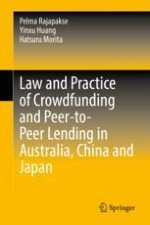2022 | OriginalPaper | Chapter
3. Challenges for P2P Lending Business Models and Banks
Author : Pelma Rajapakse
Published in: Law and Practice of Crowdfunding and Peer-to-Peer Lending in Australia, China and Japan
Publisher: Springer Nature Singapore
Activate our intelligent search to find suitable subject content or patents.
Select sections of text to find matching patents with Artificial Intelligence. powered by
Select sections of text to find additional relevant content using AI-assisted search. powered by
